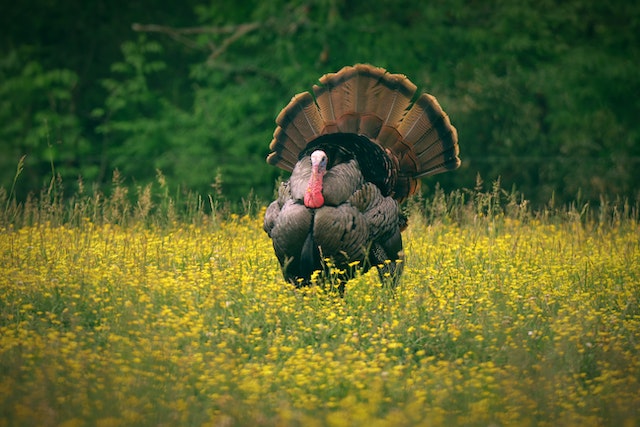How To Hunt Turkeys Using A Bow

Turkey hunting is a sport that has been enjoyed by hunters for generations, and for good reason. The thrill of the hunt, the beauty of nature, and the satisfaction of bringing home a successful harvest all combine to make turkey hunting a truly unforgettable experience.
But for those who seek an even greater challenge and sense of accomplishment, hunting turkeys with a bow offers a unique and rewarding opportunity.
Bow hunting requires a different set of skills than traditional hunting methods, including patience, precision, and the ability to move quietly and stealthily through the woods.
A successful bow hunt requires careful planning, from selecting the right equipment to scouting and tracking the turkey’s movements.
And once the moment of truth arrives, making the perfect shot requires nerves of steel and a steady hand.
In this article, we will delve into the world of turkey hunting with a bow, exploring the techniques and strategies that will help you achieve success in the field.
We’ll cover everything from choosing the right equipment, to scouting for turkeys, to setting up the perfect shot.
Whether you’re a seasoned bow hunter looking for a new challenge or a novice just getting started, this guide will provide you with valuable insights and inspiration for your next turkey hunting adventure.
So gear up, head out into the woods, and get ready to experience the thrill of the hunt like never before.
Bow Vs. Shotgun For Turkey Hunting
There are several key differences between hunting turkeys with a bow versus a shotgun. One of the most obvious differences is the range at which you can effectively take a shot.
A shotgun allows hunters to take shots at turkeys from much farther distances than a bow, which requires the hunter to get much closer to the turkey for a successful shot.
Additionally, a shotgun typically fires multiple pellets, increasing the chances of hitting the target, whereas a bow only fires a single arrow.
This means that bow hunters must be extremely accurate and precise in their shot placement, as missing the target can spook the turkey and ruin the hunt.
Another major difference is the level of noise and recoil produced by the two weapons. A shotgun can be quite loud and produce a significant amount of recoil, which can be uncomfortable for some hunters.
In contrast, a bow is generally much quieter and produces little to no recoil, allowing for a more intimate and immersive hunting experience.
Finally, there is a certain level of skill and technique required for bow hunting that is not necessary with a shotgun.
Bow hunters must be able to draw and release the bowstring smoothly and quietly, while maintaining proper form and accuracy.
This requires a great deal of practice and training, making bow hunting a challenging and rewarding experience for those who are willing to put in the effort.
Why Use A Bow To Hunt Turkeys?
Hunters opt for using a bow for turkey hunting due to various factors, including the heightened challenge and excitement it presents.
Bow hunting necessitates a greater degree of expertise and accuracy compared to shotgun hunting, as the hunter must approach the turkey at a closer range and take a more precise shot.
This increased level of difficulty can result in a more gratifying and satisfying hunting encounter.
Another reason to use a bow is the quietness and stealth it offers. Unlike a shotgun, which can produce a loud noise and recoil, a bow is much quieter and produces little to no recoil.
This can make it easier to get closer to the turkey without spooking it and allows for a more intimate and immersive hunting experience.
Using a bow can also be a more primitive and traditional way of hunting, appealing to those who prefer a more primitive and natural approach to hunting.
Additionally, some hunters may have personal or ethical reasons for choosing to use a bow, such as a desire to minimize the suffering of the animal or to challenge themselves to a higher standard of hunting ethics.
Overall, while hunting turkeys with a bow may be more challenging than using a shotgun, it can also be a more rewarding and satisfying experience for those who are up to the challenge.
Using A Blind And Calls
Using a blind and calls can greatly enhance your chances of success when turkey hunting with a bow. A blind is a hunting structure designed to conceal the hunter while allowing them to observe and take shots at their target.
Turkey calls, on the other hand, are tools used to mimic the sounds made by turkeys to attract them to the hunter’s location.
Here are some tips for using a blind and calls to make your turkey hunting experience easier and more successful.
Firstly, when setting up your blind, be sure to choose a location that offers good visibility of the surrounding area and provides cover for the hunter.
Look for areas with a clear view of turkey travel routes, such as along field edges, creek beds, or other natural funnels.
Additionally, make sure the blind is concealed by natural vegetation or brush to avoid alerting the turkeys to your presence.
When setting up the blind, try to do so a few days before the hunt, allowing turkeys to get used to its presence and increasing the chances of success.
Secondly, using calls can be an effective way to attract turkeys to your location. There are several types of calls, including box calls, slate calls, and mouth calls.
Each type of call produces a different sound and requires different techniques to use effectively. Experiment with different types of calls and find the ones that work best for you.
Make sure to practice using the calls before the hunt to ensure you can produce the desired sounds accurately.
When using calls, start by making soft, subtle sounds to mimic the sounds of a hen turkey. Gradually increase the volume and intensity of the calls to attract the attention of any nearby toms. Be patient and wait for the turkey to approach your location before taking a shot.
Finally, it is important to be patient and remain still and quiet while in the blind. Turkeys have excellent eyesight and can quickly detect movement or other signs of danger.
Avoid making sudden movements or loud noises that could alert the turkeys to your presence. Use the cover provided by the blind to remain hidden and observe the turkeys’ behavior.
Wait for the right opportunity to take a shot, and be prepared to hold steady and make a quick, accurate shot when the time comes.
Overall, using a blind and calls can greatly increase your chances of success when turkey hunting with a bow.
By selecting the right location, using effective calls, and remaining patient and still while in the blind, you can make your hunting experience easier and more successful.
Conclusion
In conclusion, turkey hunting with a bow is a challenging and rewarding outdoor activity that requires a great deal of skill, patience, and technique.
Using a blind and calls can be an effective way to increase your chances of success, allowing you to observe and attract turkeys to your location while remaining hidden and concealed.
When setting up a blind, it is important to choose a location with good visibility and cover and to set up the blind well in advance of the hunt.
When using calls, it is important to practice and experiment with different types of calls to find what works best for you.
Finally, it is important to remain patient and still while in the blind, waiting for the right opportunity to take a shot.
By following these tips and techniques, you can make your turkey hunting experience with a bow both easier and more successful.
